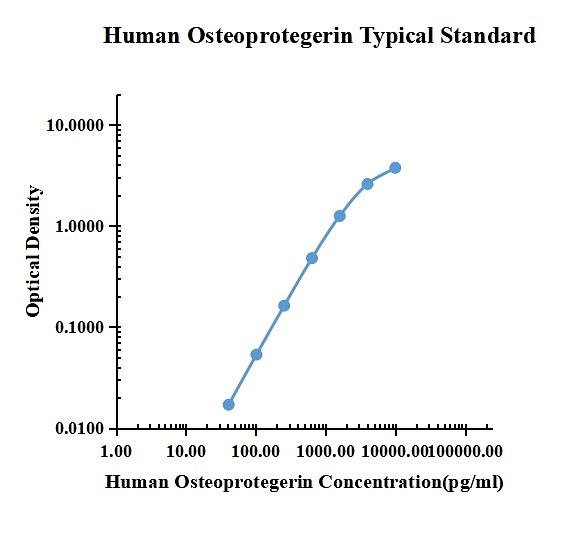Human Osteoprotegerin/TNFRSF11B enzyme-linked immunoassay kit
| Specification | 96 Test |
|---|---|
| Sensitivity | 0.37 pg/ml (50 μl);2.53 pg/ml (10 μl) |
| Standard Curve Range | 6.86~5000 pg/ml |
| Standard Curve Gradient | 7 Points/3 Folds |
| Number of Incubations | 2 |
| Detectable sample | Liquid phase sample of soluble substances. For example: serum, plasma, cell culture supernatant, tissue grinding liquid, etc. |
| Sample Volume | 50 μl/10 μl |
| Type | Fully Ready-to-Use |
| Operation Duration | 120min |

| pg/ml | O.D. | Average | Corrected | |
|---|---|---|---|---|
| 0.00 | 0.0149 | 0.0139 | 0.0144 | |
| 6.86 | 0.0332 | 0.0309 | 0.0321 | 0.0171 |
| 20.58 | 0.0686 | 0.0681 | 0.0684 | 0.0534 |
| 61.73 | 0.1782 | 0.1770 | 0.1776 | 0.1626 |
| 185.19 | 0.4947 | 0.4959 | 0.4953 | 0.4803 |
| 555.56 | 1.2700 | 1.2650 | 1.2675 | 1.2525 |
| 1666.67 | 2.6800 | 2.5420 | 2.6110 | 2.5960 |
| 5000.00 | 3.8430 | 3.6970 | 3.7700 | 3.7550 |
Precision
| Intra-assay Precision | Inter-assay Precision | |||||
| Sample Number | S1 | S2 | S3 | S1 | S2 | S3 |
| 22 | 22 | 22 | 6 | 6 | 6 | |
| Average(pg/ml) | 194.3 | 749.0 | 1558.3 | 209.4 | 735.1 | 1459.6 |
| Standard Deviation | 12.2 | 35.0 | 105.3 | 9.6 | 24.8 | 29.6 |
| Coefficient of Variation(%) | 6.3 | 4.7 | 6.8 | 4.6 | 3.4 | 2.0 |
Intra-assay Precision (Precision within an assay) Three samples of known concentration were tested twenty times on one plate to assess intra-assay precision.
Inter-assay Precision (Precision between assays) Three samples of known concentration were tested six times on one plate to assess intra-assay precision.
Spike Recovery
The spike recovery was evaluated by spiking 3 levels of human Osteoprotegerin into health human serum sample. The un-spiked serum was used as blank in this experiment.
The recovery ranged from 65% to 98% with an overall mean recovery of 95%.
Sample Values
| Sample Matrix | Sample Evaluated | Range (pg/ml) | Detectable (%) | Mean of Detectable (pg/ml) |
|---|---|---|---|---|
| Serum | 30 | 341.28- 586.42 | 100 | 461.05 |
Serum/Plasma – Thirty samples from apparently healthy volunteers were evaluated for the presence of Osteoprotegerin in this assay. No medical histories were available for the donors.
Product Data Sheet
Background: Osteoprotegerin/TNFRSF11B
Osteoprotegerin (OPG), also known as OCIF and TNFRSF11B, is a secreted TNF superfamily receptor that regulates bone density. OPG is widely expressed and constitutively released as a homodimer by mesenchymal stem cells, fibroblasts, and endothelial cells. OPG functions as a decoy receptor for TRANCE/RANK L and TRAIL. OPG regulates the cell surface expression of TRANCE and its ability to stimulate osteoclastogenesis. Dysregulation of OPG/TRANCE interactions can lead to juvenile Paget’s disease, osteoporosis, bone loss, and vascular calcification.

